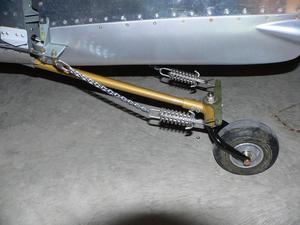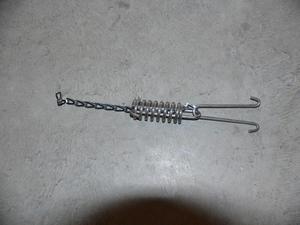I took a day of comp time on Tuesday to work on the aircraft. I woke up early, jumped in the shower, scarfed down my cereal, poured my coffee in a travel mug and headed to Rona to purchase some non-slip take for a temporary wing walk. I have a nice set of wing walks that I will install after the aircraft is painted, but I wanted a cheaper solution for the ones that will get pulled off prior to painting.
 I trimmed the front inboard corner of the wing walk to keep it clear of the intersection fairing.
I trimmed the front inboard corner of the wing walk to keep it clear of the intersection fairing.
 The eye bolts arrived from Aircraft Spruce, so I installed the tail wheel springs.
The eye bolts arrived from Aircraft Spruce, so I installed the tail wheel springs.
 It took a bit of fiddling about to get the sash chains threaded onto the tail wheel springs, but I eventually discovered that the springs could be slipped apart, so the chain could be easily put in place.
It took a bit of fiddling about to get the sash chains threaded onto the tail wheel springs, but I eventually discovered that the springs could be slipped apart, so the chain could be easily put in place.
I did a static system leak check, finding that the system was pretty much leak free, as near as I could tell. I sucked the static system to raise the altimeter 1500 ft above the starting elevation, and once I held the pressure it seemed to lose perhaps 20 ft in one minute. It was hard to hold the tube I was sucking on hard against the static port, so it is quite possible that I lost the pressure there, rather than via a leak in the static system. The allowable tolerance is a loss of 100 ft in one minute, with the system at a pressure of 1000 ft above the starting elevation.
I knocked off several other small items during the day on Tuesday and on Wednesday evening.
Today we had the annual Smiths Falls Fly-In Breakfast. The weather was horrible, so it was more of a drive-in breakfast. This is the first year I have attended, so I wasn't sure what to expect. I am now a member of the flying club, so I helped out by spending two hours on serving duties, and another hour helping to clean up.
This afternoon I made and installed a "Roll Trim Inop" label to put beside the roll trim indicator (I'll hook up the spring bias system after I have sorted out any wing heaviness). I installed the instrument panel LED flood lights, and figured out why the engine instrument and avionics dimmers weren't working when I checked them a few days ago. It turns out that they work just fine if you have the main bus powered, rather than be an idiot and try to do a functional test with only the essential bus powered. I designed the system so that if the main bus is off line, the cockpit flood lights are still powered, but the engine instrument and CDI lights are dead. The dimmer for the avionics lights is unpowered, but I have the avionics configured to switch to using their internal photocell to set the lighting intensity if the dimmer power is dead.
While I was in the cockpit, checking the lighting, I noted that the magnetic compass was reading about 140° in error. This seems to be caused by the perhaps too close proximity to the steel canopy bow/roll bar. I pondered this issue on the way home, and eventually came up with a series of fall back plans. Plan A is to hope that there is enough authority in the adjusting magnets on teh compass to correct for this large error. This probably won't work. Plan B is to temporarily move the compass on top of the instrument panel, in the location where the accelerometer currently is located. This should allow me to get a valid compass swing, and allow the flight testing to start. Then I would somehow degauss the roll bar, allowing me to put the compass back in its location at the side of the instrument panel. Plan C, if I can't get the roll bar degaussed, is to make a new bracket for the top of the instrument panel, with the compass and the accelerometer beside each other.
I have taken Monday off, and hope to finish tidying up the wiring ahead of the instrument panel, and make some progress on the interface between the cowling air inlet and the plenum chamber on top of the engine.